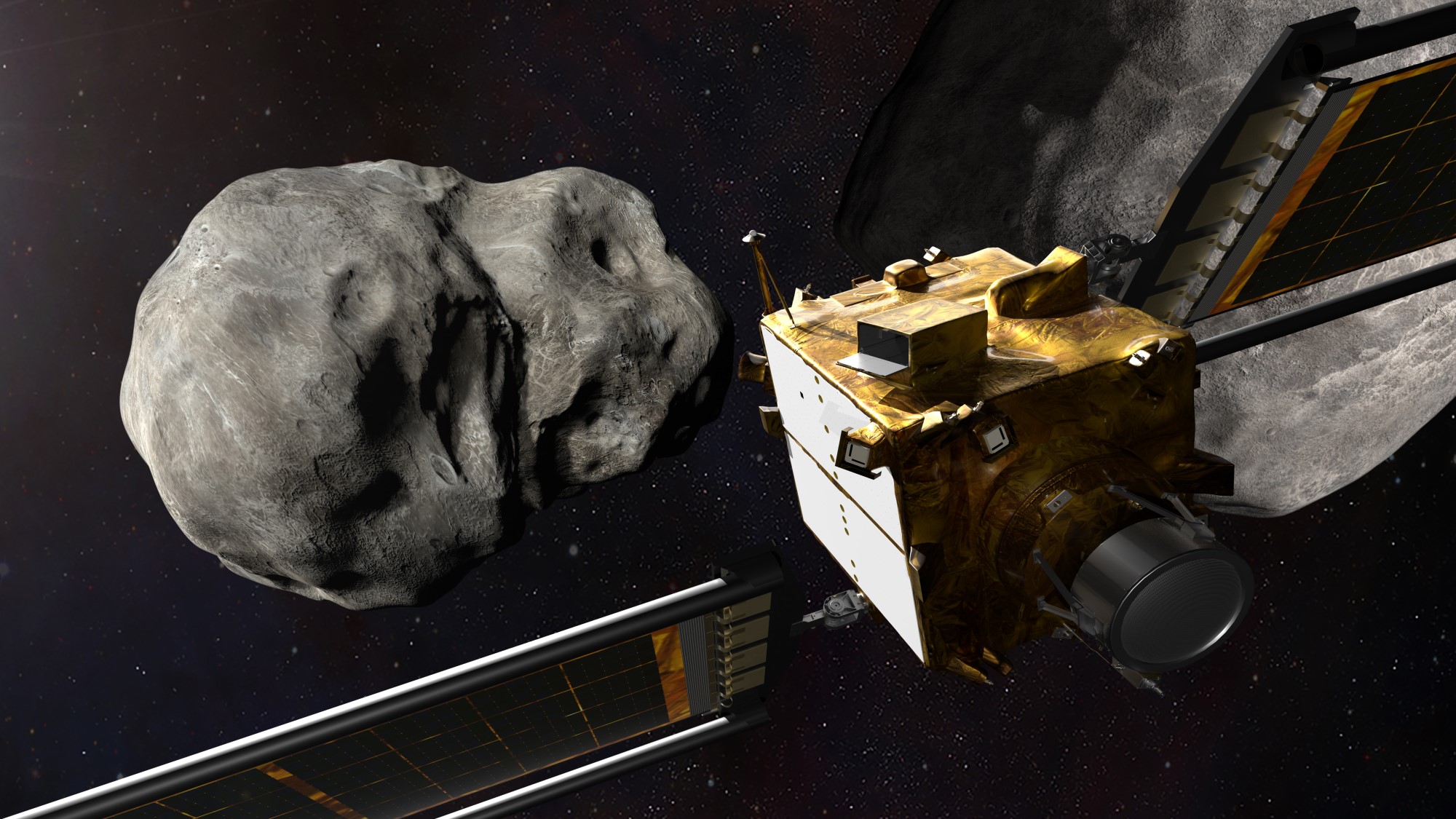NASA probe ready to slam into an asteroid this month in landmark planetary defense test
On Sept. 26, DART will slam headfirst into a small asteroid. You know, for science.

In two weeks, NASA will open a new era for the solar system.
The milestone comes courtesy of the Double Asteroid Redirection Test (DART) mission, which launched just last fall. On Sept. 26, DART will slam headfirst into a small asteroid, the rare case when a spacecraft's destruction is the desired outcome. The mission is in the name of planetary defense, which seeks to protect Earth from any potential asteroid impacts; scientists hope that should a dangerous asteroid threaten the planet in the future, a mission like DART could avert the disaster.
"These objects are hurtling through space and have of course scarred the moon and, over time, also on Earth have had major impacts, have affected our history," Thomas Zurbuchen, NASA's associate administrator for science, said during a news conference held on Monday (Sept. 12).
Related: NASA's DART asteroid-impact mission explained in pictures
"A series of new missions that we put in place are actually helping us understand and quantify those threats in an unprecedented fashion," Zurbuchen added. "DART is a first mission to try to really bump out of the way an object of threat in a direct experiment."
Scientists have identified and mapped the orbits of nearly 30,000 asteroids that rattle around the solar system in Earth's neighborhood. All of those space rocks either never cross paths with Earth or are so small that, if they did, they would harmlessly burn up in Earth's atmosphere. Still, it's possible that an asteroid impact in the future could harm Earth, and planetary defense experts want to be ready.
The theory goes that if scientists ever detected an asteroid on a collision course with Earth, an impactor probe could realign the orbit of the space rock, ensuring that it crossed Earth's path when our planet was a safe distance away. But scientists don't want to be working only from theory if the situation arises.
Get the Space.com Newsletter
Breaking space news, the latest updates on rocket launches, skywatching events and more!
That's where DART's dramatic destruction comes into play. The spacecraft will slam into a small asteroid called Dimorphos, which like clockwork orbits a larger near-Earth asteroid called Didymos every 11 hours and 55 minutes. (Neither asteroid poses any threat to Earth, and DART won't change that.) The DART impact should adjust the orbit of Dimorphos, cutting its circuit by perhaps 10 minutes.
Scientists on Earth will be spending weeks after the impact measuring the actual change in the moonlet's orbit to compare with their predictions. The work will refine scientists' understanding of how asteroids respond to impactors and help to tune any future missions to the necessary amount of orbital change.
"This isn't just a one-off event," Nancy Chabot, the DART coordination lead at the Johns Hopkins University's Applied Physics Laboratory in Maryland, which runs the mission, said during the news conference. "We want to know what happened to Dimorphos, but more important, we want to understand what that means for potentially applying this technique in the future."
While the stakes are low compared to any scenario that would motivate a real asteroid-deflecting mission, the difficulty is the same.
"This is incredibly challenging," Evan Smith, the deputy mission system engineer, said during the news conference, noting that the spacecraft will only be able to see Dimorphos itself about an hour and a half before impact. "This is a par-one course, so we're going in for the hit this time."
And if something doesn't go according to plan? Mission personnel are pretty confident that, as long as the spacecraft hits its target, there should be something to see.
"If DART collides with Dimorphos and then you don't see any orbital period change, this would be exceptionally surprising," Chabot said. "Just the amount of momentum that DART is bringing in on its own from the weight of the spacecraft slamming into Dimorphos is enough to shift its orbit in a measurable way."
Missing the moonlet is still a possibility, but that's kind of the point of DART: to work out what would-be planetary defenders need to know if they ever want to launch a real asteroid-deflecting mission.
"This will give us all confidence that deflection technology could work in the future," Andrea Riley, a program executive at NASA working with the agency's Planetary Defense Coordination Office, said during the news conference. "If it misses, it still provides a lot of data. This is a test mission. This is why we test; we want to do it now rather than when there is an actual need."
Email Meghan Bartels at mbartels@space.com or follow her on Twitter @meghanbartels. Follow us on Twitter @Spacedotcom and on Facebook.
Join our Space Forums to keep talking space on the latest missions, night sky and more! And if you have a news tip, correction or comment, let us know at: community@space.com.

Meghan is a senior writer at Space.com and has more than five years' experience as a science journalist based in New York City. She joined Space.com in July 2018, with previous writing published in outlets including Newsweek and Audubon. Meghan earned an MA in science journalism from New York University and a BA in classics from Georgetown University, and in her free time she enjoys reading and visiting museums. Follow her on Twitter at @meghanbartels.









